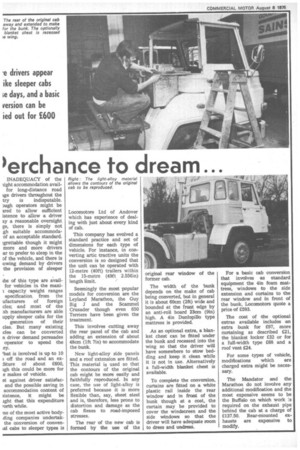oerchance to dream...
Page 46

If you've noticed an error in this article please click here to report it so we can fix it.
INADEQUACY of the light accommodation availfor long-distance road • tge drivers throughout the try is indisputable. )ugh operators might be axed to allow sufficient istence to allow a driver ay a reasonable overnight ge, there is simply not gh suitable accommodaof an acceptable standard. grettable though it might more and more drivers ax to prefer to sleep in the of the vehicle, and there is owing demand by drivers the provision of sleeper tbs of this type are availfor vehicles in the maxii capacity weight ranges specification from the ufacturers of foreign cies; and most of the sh manufacturers are able upply sleeper cabs for the generation of their des. But many existing des can be converted n driver demand persuades operator to spend the ey.
'hat is involved is up to 10 3 off the road and an exliture of about £600, igh this could be more for e makes of vehicle.
et against driver satisfacand the possible saving in 'accommodation content of 3istenoe, it might be Ight that this expenditure rorth while.
,ne of the most active bodyding companies undertakthe conversion of convenLai cabs to sleeper types is Locomotors Ltd of Andover which has experience of dealing with just about every kind of cab.
This company has evolved a standard practice and set of dimensions for each type of vehicle. For instance, in converting artic tractive units the conversion is so designed that the unit can be operated with 12-metre (40ft) trailers within the 15-metre (49ft 2.556in) length limit.
Seemingly the most popular models for conversion are the Leyland Marathon, the Guy Big .1 and the Scammel Crusader though even 650 Terriers have been given the treatment.
This involves cutting away the rear panel of the cab and adding an extension of about 48cm (1ft 7in) to accommodate the bunk.
New light-alloy side panels and a roof extension are fitted. This material is used so that the contours of the original cab might be more easily and faithfully reproduced. In any case, the use of light-alloy is preferred because it is more flexible than, say, sheet steel and is, therefore, less prone to distortion and damage as the cab flexes to road-imposed stresses.
The rear of the new cab is formed by the use of the original rear window of the former cab.
The width of the bunk depends on the make of cab being converted, 'but in general it is about 60cm (2ft) wide and bounded at the front edge by an anti-roll 'board 23am (9in) high. A 4in Dunlopillo type mattress is provided.
As an optional extra, a blanket chest can be fitted under the bunk and recessed into the wing so that the driver will have somewhere to stow bedding and keep it clean while it is not in use. Alternatively a full-width blanket chest is available.
To complete the conversion, curtain's are fitted on a white plastic rail inside the rear window and in front of the bunk though at a cost, the curtain may be provided to cover the windscreen and the side windows so that the driver will have adequate room to dress and undress, For a basic cab conversion that invOlves as standard equipment the 4in foam mattress, windows to the side extension and curtains to the rear window and in front of the bunk, Locomotors quote a price of £593.
The cost of the optional extras available includes an extra bunk for £97, more curtaining as described £21, the blanket locker £32 or for a full-width type £68 and a roof vent £24.
For some types of vehicle, modifications which are charged extra might be necessary.
The Mandator and the Marathon do not involve any additional modification and the most expensive seems to be the Buffalo on which work is required on the exhaust pipe behind the cab at a charge of £137.50. Rear-mounted exhausts are expensive to modify.




































































































